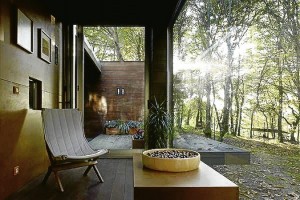
OUR vacation homes are still best enjoyed when they make the most of our tropical climate and allow us to wallow in the natural elements that exist beyond the four walls of our dwelling place.
Two and a half months to Christmas, five months to summer; the worst months of the year are almost over! Gloomy wet weather drenches the metro, dampens our spirits and creates havoc in the city—of the kind we can only bear for too long. The “ber” months bring the promise of clearer skies and the chance to spend more time enjoying the outdoors. It adds to the meaning of a merry Christmas. With the northeast winds blowing, even the nice warm days of summer will be just right around the corner.
We eagerly look forward to our holidays for the breather they give us: an escape from the urban grind, a time to play and just be. They are almost always earmarked for an out-of-town trip, and often to one’s own or a borrowed second home. It is almost as if being in great outdoors further supports that feeling of, and longing for, liberation.
Opening our abode to the outdoors while in the middle of the city isn’t quite ideal: it makes us vulnerable to pollution, exposed to city noise, and to the unwanted views of our neighbors. Fortunately, there are many developments at the fringes of the metro that have the green and outdoor lifestyle in mind. A few weeks back, we took a short drive south and visited Ayala Land Premiere’s “Elaro.”
Purposely planned as the greenest of the Nuvali’s communities in Santa Rosa, Elaro has a density of six lots per hectare and showcases naturally rolling terrain, mature trees and views of the surrounding hills of Tagaytay and Makiling. It even has a bird sanctuary which, at 14 hectares, is almost equivalent to 20 percent of the community’s land area.
Outdoor haven
While it’s easy to go green and “outdoorsy” within the boundaries of your own property, what developments like Elaro deliver is a physical framework for true outdoor living. For an entire community to be an outdoor haven, its character must grow out from the existing terrain and be carefully thought through the following:
- the allotment of areas for development;
- the preservation of existing ecosystems with its flora and fauna;
- the prudent design of “hard surfaces” such as roads and sidewalks (that they may be pedestrian friendly and sensitive to the lifestyle patterns of an outdoor-living community); and,
- the guidance given to lot owners through the building restrictions.
Seemingly insignificant details like fence heights, regulations on tree-cutting, building setbacks and other limitations also allow the natural climate—wind and its cooling effect—to permeate through the community and affect each home in the most positively natural way: as per mother nature’s design.
Setting limits on the buildable area per lot controls the human density of the site, and thus tilts the scale in favor of the unbuilt or natural environment systems, further supporting the workings of the outdoor community concept.
Panorama of green views
What it also makes available is a panorama of green views and vistas that are experienced from the indoors. These communities provide the opportunity to strip a home bare of all its concealments and coverings, and promote more terrace spaces, large windows, wrap-around balconies, open-air bathrooms and open-air anything! Its building envelope can be less fortified and instead, be so perforated that it almost seamlessly integrates into its setting. Aside from the visual, there are also the auditory and kinesthetic experiences—the rustling of leaves, chirping of birds, the breeze on one’s cheeks—that enhance the visual enjoyment of the outdoor experience.
I have been to communities in vacation spots like Nasugbu or Tagaytay that promote themselves to be outdoor-friendly, but have planned their communities so badly, homeowners are forced to build homes that are better suited to the city—small windows, expansive walls and oriented toward the indoors—all because the planning of the community and its support systems are just that—city-like—and with no sensitivity to the outdoor environment and how the human sensibilities can make the most of it.
Our vacation homes are still best enjoyed when they make the most of our tropical climate and allow us to wallow in the natural elements that exist beyond the four walls of our dwelling place. Thus with wide roof eaves, we are protected from rain and direct sunlight, with tall windows hot and cool air are allowed to flow, and with high ceilings heat is pulled upward and away from our bodies. The more open the structure, the better it adapts to our climate. And the more beautiful our surroundings, the more we’d like to draw its charming greatness into our homes. And when drawing it physically is not possible, visually could very well be enough.